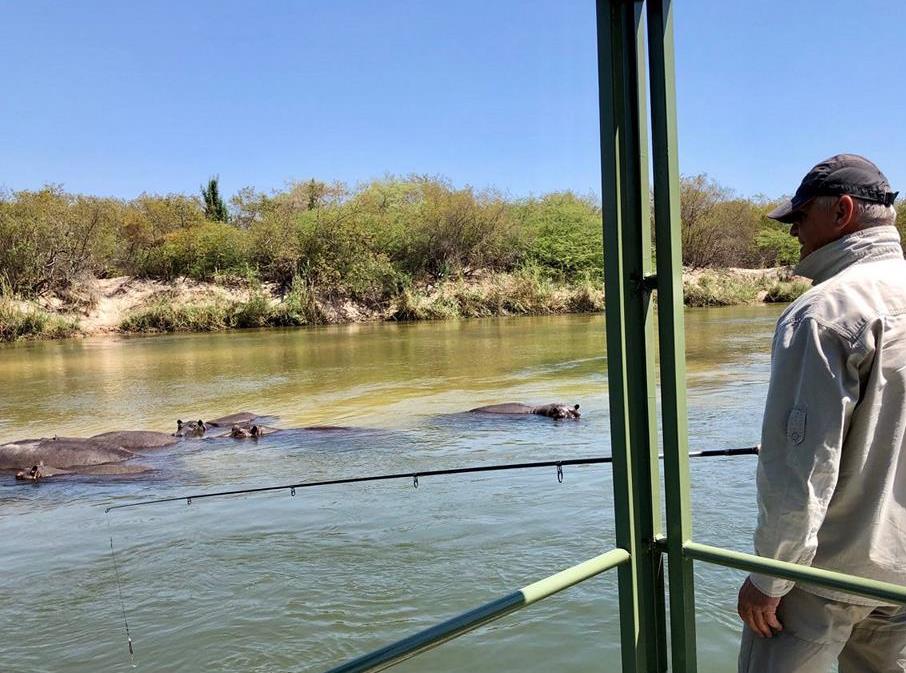Tigerfish hold a similar significance for Africans as the bass for Americans or carp for Europeans. These three fish species effectively represent the human populations on their respective continents. Tigers are my favorite, as they possess a remarkable blend of agility, strength, and elegance. No other freshwater fish in the world can match the mid-sized Tigerfish when it comes to effortlessly leaping out of the water. This can either capture flying swallows or free themselves from a hook. You can watch a video showcasing their incredible ability to catch a bird in flight here.
Tigerfish description


Currently, Africa is home to five officially recognized species of Tigerfish (Hydrocynus), as indicated in this link. “Hydrocynus” derives from Latin words meaning “Water dog.”
Among these species, two are particularly prevalent. The first is the common Tigerfish (Hydrocynus vittatus), which inhabits the Zambezi River system. It is widely regarded as one of the world’s premier gamefish, as stated in Britannica. The second species is the Goliath Tigerfish (Hydrocynus goliath), found in the Congo River and Lake Tanganyika. It’s important to note that this article’s pictures and statements pertain specifically to the Hydrocynus vittatus species.




Tigerfish are renowned as the fastest freshwater fish globally, displaying impressive speed and agility. They are also known for their ferocious, predatory nature. Tigerfish often hunt in groups when they are young, while older individuals hunt independently. Notably, their prominent teeth are firmly embedded in bony sockets. When broken, they are replaced by new teeth growing from beneath. Attached are some photos showcasing these features.
Numerous resources on the Internet provide more comprehensive information and general descriptions of Tigerfish. See also the following link.
Fishing locations
In mid-October, we embarked on a fishing expedition targeting Tigerfish at three locations connected to the Zambezi river system.



Our first fishing spot was the Kavango River, located below Popa Falls near Divundu. The Kavango River stretched approximately 100 meters wide and boasted a pristine, untouched environment abundant with hippos.
Moving on, we arrived at the Kwando River (known as Linyanti in Botswana) near the Gudumu Game Reserve. The Kwando River was relatively narrow, measuring only about 30 meters across. It featured swift-flowing sections and occasional widening into expansive pools, attracting a significant population of hippos.
Our final fishing destination was a secluded area on the Zambezi River, far east of Katima Mulilo. This particular location could only be accessed by boat. The Zambezi River exhibited a formidable, medium-fast flow, maintaining its natural state and thriving with sizable crocodiles.
Fishing methods for Tigerfish in the Zambezi river system
Spinning
When targeting Tigerfish in the Zambezi River system, it is recommended to use specific gear that can handle the strength and agility of these fish. Here are some guidelines for the preferred rods, reels, and lines.


Rods
Short and stout rods with a stiff action are preferred for Tigerfish fishing. A rod length of approximately 1.6 meters (5.2 feet) is recommended. This rod type provides the necessary power and control when battling these strong fish.
Reels
Reels ranging from size 2000 to 3000 are suitable for Tigerfish fishing. The spinning reel’s brake system should be tight, allowing the line to be pulled off only with considerable force from the angler.

Lines
Braided lines are commonly used for Tigerfish fishing due to their strength and reduced stretch. They allow for longer and more accurate casts. However, some anglers also use monofilament lines. Opting for braided lines to minimize line stretch when Tigerfish jump is generally preferable if given a choice. It’s essential to regularly inspect the knotted area between the braided running line and the swivel for signs of abrasion or damage.
A shock leader, typically a 4-meter (13 feet) long monofilament line between the swivel and the braided running line, can prevent potential weaknesses at the connection between the braided line and the swivel. This helps protect the line from abrasion and provides added strength. A well-tied Bimini twist knot can also reduce friction.
Artificial baits for spinning
When using artificial baits, a common practice is to attach the bait directly to a 30 cm (12 inches) long wire and a swivel connected to the running line. It’s important to note that the swivel should not have a shiny appearance, as this could potentially attract the Tigerfish to bite into it. Consequently, clip-in carabiners or shiny metal attachments are not used for quick lure changes to avoid the Tigerfish mistaking them for prey and biting into them. The focus is on using a simple and inconspicuous setup to entice the Tigerfish to strike at the artificial bait.
Spoons


A spoon with two blades is a popular and effective artificial lure for Tigerfish. These blades are connected to both ends of the spoon using rings, creating a setup that produces rattling sounds and attracts fish. Single-blade spoons weighing 24 to 30 grams (0.85 to 1 oz.) are also commonly used and have shown similar success. When it comes to color preference, silver and copper are popular choices for spoons. Additionally, spoons with silver or gold finishes and a red stripe on the top have also proven effective in enticing Tigerfish strikes.

Due to the bony nature of both the upper and lower jaws of Tigerfish, it is recommended to use spoons with a single hook. These hooks should have a long shank to facilitate deeper hooking in the fish’s mouth. Additionally, the hooks should have only a tiny barb to minimize potential injuries to the fish during hook extraction.
Other lures


Indeed, spoons are not the only artificial bait utilized for Tigerfish fishing. Anglers also employ a range of other lures, such as spinners, wobblers, plugs, and even spinnerbaits commonly used for bass fishing. When it comes to hooks, larger single hooks are often preferred over treble hooks. The choice of lure color for Tigerfish can be unpredictable, and the most effective colors for specific conditions may require some experimentation and trial and error.
Fishing, drilling, landing & releasing Tigerfish

Spinning for Tigerfish is typically done in deep pools or fast-flowing stretches of the river. Keeping the rod tip low to the water surface is essential when casting the lure.
When a bite is detected, setting the hook sideways and against the direction from which the fish is coming while keeping the rod tip near the water surface is crucial. Hooked Tigerfish often jump about 1 meter above the water surface to shake off the hook. Keeping the rod tip low shortens the line, helping to maintain tension and control over the fish. Conversely, a higher rod tip position could result in the tension of the line being released.
Maintaining continuous tension and pulling on the line throughout the fight is vital. Tigerfish swim at high speeds and often jump toward the pulling line, attempting to shake off the hook with vigorous head movements. Approximately 50% of the time, they are successful in their escape attempts through these actions. It is worth noting that fish in the 3-4 kg (6-8 lb.) range tend to jump more frequently than those weighing 5 kg (10 lb.) and above.

Bites can occur at any time while the lure is in the water. In some instances, bites have happened when the lure was just 1 meter away from the fishing platform, resulting in lost opportunities if not handled promptly.
Additional influences to be aware of
Hippos in the water can be advantageous fishing spots for Tigerfish. These animals spend most of the daytime in deep pools, and when they defecate in the water, it attracts smaller fish that serve as prey for Tigerfish.
It is essential to be cautious of crocodiles when spinning from water edges or wading in the water. One should always watch for signs of crocodiles in the surrounding water body. Changing fishing locations at regular intervals is advisable, moving at least 5 meters every 5 seconds. This helps prevent crocodiles from orienting themselves accurately towards the water’s edge, as they require time to position themselves precisely before launching an attack on their prey.
Trolling

Trolling for Tigerfish is a fishing technique commonly employed by fishing guide operators. It allows them to cover a larger area compared to wading and spinning and helps them avoid the potential dangers associated with crocodiles. The equipment used for trolling is similar to that used for spinning, and the technique itself does not require extensive skills or specialized knowledge.
When trolling for Tigerfish, preferred baits include large and deep-running wobblers with a length of approximately 12 cm (5 inches). These wobblers come in a variety of colors to attract tigerfish’s attention. Using large treble hooks on these baits is essential to increase the chances of hooking the fish effectively.
Live baiting
The following picture shows a typical rig for live-baiting Tigerfish. This rig is designed to present the live bait effectively and attractively to the Tigerfish, increasing the chances of a successful strike.

Live baiting is considered one of the most productive methods for catching Tigerfish. This technique is typically employed in the evening when it is already dark. However, it is essential to note that live baiting can be dangerous for the fisherman due to crocodile’s increased activity during this time.
To mitigate the risks associated with live baiting, it is recommended to fish from a platform positioned well above the water surface. This helps minimize the chances of crocodiles approaching from below. Additionally, it is advisable to change fishing positions regularly to avoid gallowing crocodiles from approaching unnoticed.
When engaging in live baiting, it is ideal to fish in the deepest and fastest-flowing parts of the river whenever possible. Tigerfish tend to be more active in these areas, increasing the likelihood of successful catches.
Baitfish used for life-baiting Tigerfish primarily consist of small Breams and ‘Bulldogs’. Small Breams from Tilapia species can be caught using a hook and line in the area.

Conversely, bulldogs can include various species of snout-fishes such as stone bashers, bulldogs, bottlenose, or Churchill species. These hardy species can be captured using fish traps or slip baskets in flood plains.

Fly fishing
Fly fishing for Tigerfish is becoming increasingly popular, particularly in South Africa, where these fish are found in rivers such as the Pongola and the Komati.
A 9 ‘8wt rod is a versatile rod choice for fly fishing. It provides the appropriate power and flexibility needed to handle Tigerfish. Pairing it with a quality reel with a sound drag system is crucial for effectively battling these powerful fish. Spooling the reel with an intermediate fly line allows proper hook setting and control of the fish’s powerful runs toward structures.
Classic streamer patterns such as “Clouser Deep Minnows” and “Lefty’s Deceivers” work well for Tigerfish and are available in various colors. The critical factor for success is ensuring that the hooks on the flies are razor sharp, as Tigerfish have bony mouths that require a solid hookset.
Illegal catching of Tigerfish

I believe it is crucial to consider the local population and their livelihoods when managing river fishing access. Many individuals may be economically disadvantaged and depend on fishing for food and additional income. This holds particularly true on the Angolan and Zambian sides of the rivers. Providing the local population with the opportunity to fish using legal methods will support their basic needs. However, on the Namibian side, the standard of living is comparatively higher. Here, stricter monitoring could be implemented to ensure the sustainability of fish populations.
Fish poaching at the Kavango
Fishing should be conducted sustainably and legally, adhering to the regulations established by the authorities. Unfortunately, we witnessed a poaching incident on the Kavango River.

Our chalet was situated right by the riverbank. In the middle of the night, at 1 am, we were awakened by the sight of two Mokoros (dugout canoes) on the river. People with headlamps were busy setting up a circular net with a diameter of approximately 50 meters. The net had a very fine mesh, shimmering like a mirror in the darkness. The legal mesh size should have been 10 x 10 cm (4″ x 4″). The poachers showed little concern for being discreet, as we could hear them talking. The following morning, we reported the incident to the lodge owner, who was unsurprised. It seems that poaching is a regular occurrence, even on the Namibian side. The lodge owner explained that the lodge security would not witness anything as they reside in the same village as the poachers.
Fishing pressure and unsuitable tackle at the Zambezi

During our time on the Zambezi River, we observed many Tigerfish we caught carrying remnants of old fishing gear, indicating previous fishing activity. Some fish had hooks hanging from their mouths, with or without lines, while others were entangled in net meshes. The lines or nets were often too thin, and the knots used were poorly executed. It is implausible that recreational fishermen or fishing guides would employ such unsuitable tackle. When we encountered these situations, we removed the remnants from the fish and released them back into the water. However, the issue of overfishing, coupled with inadequate government control, remains a concern.
On returning to Rundu, we encountered individuals selling fish by the roadside. As we released all the tigerfish we had caught, I purchased a dead tigerfish from one of the fishermen to taste for dinner. In hindsight, I realize this only contributes to promoting fishing for economic gain using any means necessary, which is problematic.
Lessons learned from catching Tigerfish:
- There are two primary species of Tigerfish in Africa: the common Tigerfish, which inhabits the Zambezi River system, and the Goliath Tigerfish, found in the Congo River system.
- Tigerfish in the Zambezi River system are highly prized as some of the world’s most sought-after freshwater gamefish.
- When hooked, Tigerfish tend to jump about 1 meter into the air and vigorously attempt to shake off the hook.
- Due to their bony jaws, Tigerfish successfully free themselves from the hook in approximately 50% of cases.
- Catching Tigerfish includes trolling, live baiting, and fly fishing.
.





